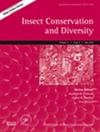Similar temporal patterns in insect richness, abundance and biomass across major habitat types
IF 3.2
2区 农林科学
Q1 ENTOMOLOGY
引用次数: 0
Abstract


主要生境类型昆虫丰富度、丰度和生物量的时间格局相似
近年来,关于昆虫区系状态和时间趋势的研究(如Hallmann et al., 2017;van Klink et al., 2020)已经获得了许多科学和公众的关注。虽然大多数关于时间趋势的研究都集中在物种丰富度和/或单个群体的丰度或占用上(例如,Habel等人,2019;Janousek et al., 2023;Jönsson et al., 2021),其他研究只关注整体模式的生物量,而没有进一步的分类分类(Hallmann et al., 2017;m<s:1> ller等人,2023)。同时评估物种丰富度、丰度和生物量的时间趋势是罕见的(但见f<s:1> rst等人,2022;Seibold et al., 2019)。然而,只有通过对丰富度、丰度和生物量数据的联合分析,才能评估昆虫多样性趋势及其对生态系统功能和服务提供的潜在影响(Hallmann et al., 2021)。此外,为了得出全面的结论,对多个昆虫类群进行评估至关重要,因为很少有证据表明一个指标分类单元能够反映所有昆虫分类单元的趋势(van Klink et al., 2022)。作为昆虫趋势的潜在驱动因素,气候和土地利用相关因素最为突出(Outhwaite et al., 2022)。关于司机的重要性、他们的相互作用以及他们的强度随空间和时间的变化,仍然存在实质性的模糊性(Wagner et al., 2021)。由于它们的变温性和体积小,昆虫特别容易受到环境温度和湿度变化的影响。因此,天气在决定昆虫栖息地的利用和分布方面起着重要作用(Wilson et al., 2007)。作为对气候变化的响应,物种可能会改变它们在空间和/或时间上的分布。气候变化最常见的变化是物种地理范围的变化和物候变化(Wilson et al., 2007)。昆虫分布或物候的变化也可能影响物种之间的相互作用,要么导致物种之间的时空不匹配,可能涉及多个营养水平,要么导致以前在空间或时间上隔离的物种之间出现新的相互作用(Harvey et al., 2022)。土地利用变化导致栖息地丧失、碎片化、农业集约化和放弃传统的土地利用做法(Wagner, 2020)。据报道,土地利用强度会对昆虫的丰富度和丰度产生强烈影响(例如,msamudez - rojas等人,2021年)。特别是,由于重复的机械干扰以及化肥和农药的使用,农业实践对昆虫产生了负面影响(Wagner, 2020)。林业实践的危害较小,因为它们只在多年的频率中发生,但它们可以强烈地改变自然状态下的树种组成和林分结构(Grove, 2002)。一般意义上的未管理栖息地或植被管理以保护目标为导向的栖息地应支持高昆虫多样性(Frenzel et al., 2021)。一般来说,预计不同物种对气候和土地利用变化的反应将是特定的。通才物种和专业物种将受到不同的影响,全球变化将有赢家和输家(Habel et al., 2019;Neff et al., 2022)。我们考虑了鞘翅目、膜翅目、异翅目和鳞翅目。为了获得更细致的模式,我们将鞘翅目昆虫分为布氏科、天牛科和甲虫科,并将剩余甲虫的结果汇总起来。对于膜翅目,我们分别评估了针叶亚目和其余膜翅目的模式。我们之所以选择这些分类群,是因为它们代表了昆虫的主要功能类群,即传粉昆虫(除小甲虫科外的所有昆虫)、食草动物(除小甲虫科外的所有昆虫)、食肉动物(除小甲虫科外的所有昆虫)和分解昆虫(除小甲虫科外的其他膜翅目昆虫)。为了探讨温度和降水以及主要生境类型对瑞士昆虫多样性的影响,我们分析了2000年至2007年42个研究点的年度数据。42个地点分布在三种生境类型:农业和管理生境各15个,非管理生境12个。未受管理的研究地点由6个未放养的开放研究地点和6个未受管理的森林研究地点组成。由于昆虫趋势的模式已被证明在栖息地之间存在差异(Seibold et al., 2019),因此对三种栖息地类型分别进行了分析。我们将温度和降水作为天气相关因子,而将归一化植被指数(NDVI)作为土地利用相关因子。后者作为植被覆盖和植被活动的度量(Pettorelli et al., 2011;Weber et al., 2018)。 研究结果表明:2000 - 2007年昆虫形态、物种丰富度、丰度和生物量的变化趋势是否存在差异?农业、有管理的森林和无管理的栖息地(包括无管理的开放栖息地和无管理的森林栖息地)这三种栖息地类型之间的模式是否不同?汇总数据和八个不同分类群的趋势是否相似?哪些环境预测因素正在影响趋势?
本文章由计算机程序翻译,如有差异,请以英文原文为准。
求助全文
约1分钟内获得全文
求助全文
来源期刊
CiteScore
7.70
自引率
8.60%
发文量
58
审稿时长
>12 weeks
期刊介绍:
To publish papers of the highest scientific quality within the general area of insect (and other arthropods) conservation and diversity covering topics ranging from ecological theory to practical management.
Papers are invited on the following topics: Conservation genetics; Extinction debt; Long-term conservation planning and implementation; Global implications of local or national conservation actions; Management responses of species and communities; Captive breeding programs; Comparisons of restored and natural habitats; Biogeography; Global biodiversity; Metapopulation dynamics; Climate change: impacts on distributions and range; Invasive species: impacts and control; Effects of pollution; Genetic threats to diversity by introgression; Effects of fragmentation on diversity and distribution; Impact of agricultural and forestry practices on biodiversity; Enhancing urban environments for diversity and protection; Biodiversity action plans: can we scale up from insects?; Effectiveness and choice of indicator species; Soil biodiversity and interactions with above-ground biodiversity; Ecological interactions at local levels; Ecological and evolutionary factors influencing diversity and local, regional and global scales; Sustainable livelihoods and training on the ground; Integrating science and policy.

 求助内容:
求助内容: 应助结果提醒方式:
应助结果提醒方式:


